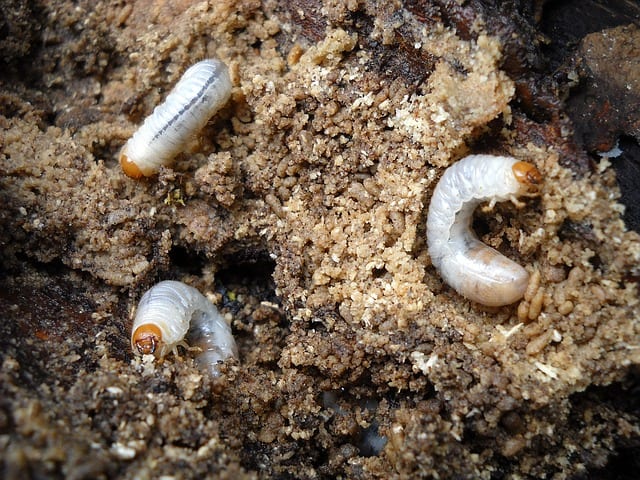If you’re looking for an amazing pest control option that is both organic and insanely effective, we’ve got what you desire in the form of beneficial nematodes. Adding beneficial nematodes to your spring garden arsenal is a great way to fight off soil dwelling pests that want nothing more than to destroy your newly greening up turf. With beneficial nematodes, you can easily apply a safe pest control to your lawn that increases its potency over time. Intrigued? Let me tell you more.
What are Beneficial Nematodes?
Beneficial nematodes are microscopic round worms that kill the larvae and grub stage of insects but are harmless to other organisms (no birds, or mammals will be harmed in the releasing of the nematodes).

How do Beneficial Nematodes Work?
- Beneficial nematodes enter a host and release bacteria into it. The host dies from blood poisoning a few days later.
- The beneficial nematodes feed upon the bacteria and degrading host tissue. As they feed, they continue to develop and thousands of beneficial nematodes are produced following a single host infection.
- When the body wall of the dead host ruptures, usually within 2-3 days, beneficial nematodes are released and free to move on to another host to infect.
- They continue reproducing and multiplying and soon you have an army of beneficial nematode invaders.
Sounds a little like something out of a Stephen King novel, doesn’t it? But the end result is just awesome enough to balance out the gruesome details. Beneficial nematodes thrive in moist conditions, so as long as they can swim around in your soil depths, they can continue to attack the pests in your turf.
What Type of Pests do Beneficial Nematodes Control?
Beneficial nematodes are the bomb when it comes to attacking and controlling soil dwelling pests. A few pests they attack and devour are: grubs, cut-worms, army worms, fungus gnats, chinch bugs, fleas, ants. But that is just naming a few. You can see a list of more pests they control here.

Special Reminders for Effectiveness of Beneficial Nematodes.
- Temperature: We keep beneficial nematodes in a refrigerator at the garden center and you should do the same until you are ready to apply them. This means don’t buy them and keep them in a hot car while you do extra errands. Make your nematode stop your last one before home. Beneficial nematodes are effective when the soil temperatures are in the range of 42° – 95°; making spring a perfect time to apply them.
- Clean containers: Make sure whatever sprayer, bucket, hose adapter, etc… you choose to use is designated only for the application of beneficial nematodes. You don’t want to use a hose end sprayer that has housed a pesticide, fungicide, or fertilizer at any time prior.
- Water: Beneficial nematodes are swimmers. They need to be released into a clean bucket of water (gallon size or larger is best). When you apply them, you need to water them in really well. After a good soaking rain is a perfect time to apply beneficial nematodes as the soil will be nice and saturated, but you should still water them in afterward.
Applying Beneficial Nematodes
- Place the sponge containing beneficial nematodes in a clean, uncontaminated bucket.
- Pour at least two quarts to a gallon of water over the sponge and squeeze the sponge for a couple of minutes to release the beneficial nematodes.
- Remove sponge and discard, and add extra clean water. You can always add more water if needed for your sprayer volume and to cover the square footage of your turf. (One sponge covers 2,000 – 3,000 sq. ft.)
- Pour water into clean, uncontaminated hose-end sprayer and saturate your lawn.
- Keep lawn well watered for the following 10 days after application to ensure your beneficial nematodes have been able to swim down to the depths of your soil to do their dirty work.
Beneficial nematodes are also a great organic pest control option for your garden beds, vegetable beds, and indoor and outdoor potted plants. Why not give them a try today?
~The Happy Gardener, Lisa Mulroy


Do insecticides like Amdro or grub control harm the nematodes?
Hi Sharynn,
Yes, unfortunately if you apply a synthetic pesticide, you will be essentially killing of your beneficial nematodes. Nematodes themselves have proven to be a great army against pest like grubs and ants…What problems are you finding?
Would they control the larva\pups of the small hive battle (Athena tumida)?
Hi Scott,
There has been some research that the beneficial nematodes can help in controlling the larval stage of these beetles. However, being able to attack all 3 stages of the life cycle may be most beneficial. A soil drench with beneficial nematodes is helpful, but know that the larvae have been known to travel some distance from the hive for suitable soil to grow in (Just keep that in mind when applying.)
“For example, one may consider using hygienic queens (bees remove beetle eggs and young larvae), in-hive traps (catch adult beetles), and nematodes around colonies (kill pupating beetles) to attack all beetle life stages. While no single beetle control boasts 100% efficacy, employing multiple control strategies may limit beetle populations to manageable levels.”
Quote taken from Featured Creatures
Do these amazing nematodes also kill springtails in the dirt?
Hi Stephanie,
Don’t think they would completely solve your problem. You are best off finding and getting rid of the elements that are attracting them and causing them to nest in that area. Do you have soil that does not drain well? This could cause a soil fungus to develop and attract the pests. You should try removing as much of the infested soil, completely replacing is best if you can (if it is in a pot or other container). If not all material is removed, you can look up “neem oil soil drench” as an option too.
will they kill lightening bug (firefly) larva?
I’m finding mixed information on this. I will hopefully get back to you with an affirmative answer.
What an awesome article. I have a redbud tree I love for personal reasons. I can’t figure out if it is an insect or fungus harming the roots. I “think” it’s getting enough water. The leaves are curled and it just doesn’t seem happy. Do you think the nematodes would be a good idea around it?
Hi Cory,
Where do you live and what are the temperatures right now? 100 degree days can cause shrubs and trees to get stressed out. How much water is your redbud getting? Curled leaves can be a sign of drought stress, but can also be a sign of leaf rollers. Do some investigating and see if there may be some caterpillars rolled up in those leaves. Leaf rollers generally don’t warrant treatment unless you notice extensive damage or excessive numbers (most leaves curled). You can try Bt (Bacillus thuringiensis) as an organic control, using a hose end sprayer. You would most likely need a 2nd application in a couple weeks, but follow label instructions. Spinosad spray also works.
What brand uses the blue sponge?
Those would be Guardian Lawn Patrol nematodes.